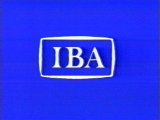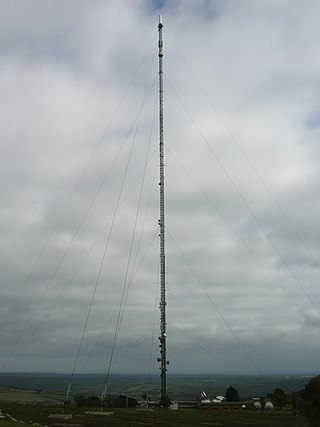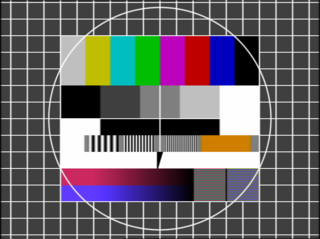
A test card, also known as a test pattern or start-up/closedown test, is a television test signal, typically broadcast at times when the transmitter is active but no program is being broadcast.

SMPTE color bars are a television test pattern used where the NTSC video standard is utilized, including countries in North America. The Society of Motion Picture and Television Engineers (SMPTE) refers to the pattern as Engineering Guideline (EG) 1-1990. Its components are a known standard, and created by test pattern generators. Comparing it as received to the known standard gives video engineers an indication of how an NTSC video signal has been altered by recording or transmission and what adjustments must be made to bring it back to specification. It is also used for setting a television monitor or receiver to reproduce NTSC chrominance and luminance information correctly.
PALplus is an analogue television broadcasting system aimed to improve and enhance the PAL format by allowing 16:9 aspect ratio broadcasts, while remaining compatible with existing television receivers, defined by International Telecommunication Union (ITU) recommendation BT.1197-1. Introduced in 1993, it followed experiences with the HD-MAC and D2-MAC, hybrid analogue-digital widescreen formats that were incompatible with PAL receivers. It was developed at the University of Dortmund in Germany, in cooperation with German terrestrial broadcasters and European and Japanese manufacturers. The system had some adoption across Europe during the late 1990s and helped introduce widescreen TVs in the market, but never became mainstream.

The Independent Broadcasting Authority (IBA) was the regulatory body in the United Kingdom for commercial television – and commercial and independent radio broadcasts. The IBA came into being when the Sound Broadcasting Act 1972 gave the Independent Television Authority responsibility for organising the new Independent Local Radio (ILR) stations. The Independent Television Commission formally replaced the IBA on 1 January 1991 in regulatory terms; however, the authority itself was not officially dissolved until 2003.
United Kingdom Independent Broadcasting (UKIB) is an affiliation of three British independent television production companies and broadcasters. The primary function of its predecessor, the Independent Television Companies Association (ITCA), was to represent independent British television interests as a member of the European Broadcasting Union (EBU). The current members of UKIB are the ITV network centre, the 4 ITV licence holders, Channel 4, and S4C.
ITV Nightscreen was a scheduled programme on the ITV television network, consisting of a sequence of animated pages of information about ITV's upcoming programmes, features and special events, with easy listening music in the background. The programme was used to fill the station's overnight downtime, where a closedown would have once been used at the end of programmes. The programme was generally shown seven days a week with the typical weekday show airing from 4:05 am to 5:05 am daily. However, on ITV's digital channels, the amount of Teleshopping affects how much Nightscreen is broadcast. The programme was also broadcast on all of ITV's +1 channels.

The Philips circle pattern refers to a family of related electronically generated complex television station colour test cards. The content and layout of the original colour circle pattern was designed by Danish engineer Finn Hendil (1939–2011) in the Philips TV & Test Equipment laboratory in Amager near Copenhagen under supervision of chief engineer Erik Helmer Nielsen in 1966–67, largely building on their previous work with the monochrome PM5540 pattern. The first piece of equipment, the PM5544 colour pattern generator, which generates the pattern, was made by Finn Hendil and his group in 1968–69. The same team would also develop the Spanish TVE colour test card in 1973.

The Preseli transmitting station is a broadcasting and telecommunications facility on the eastern end of the Preseli Mountains, close to the villages of Crymych and Pentre Galar in Pembrokeshire, Wales. It is owned and operated by Arqiva.
Analogue terrestrial television in the United Kingdom was originally the method by which the significant majority of viewers in the UK, the Channel Islands and the Isle of Man received television. Analogue terrestrial television broadcasts have fully ceased in the UK with Northern Ireland being the last region to have ceased transmission analogue terrestrial television broadcasts. Northern Ireland switched off the last analogue television signals, making all of the United Kingdom only capable of receiving digital television, in the early hours of 24 October, 2012. It has been completely replaced by digital terrestrial television and other non-terrestrial means as of the end of 2012.
There are four major forms of digital television (DTV) broadcast in the United Kingdom: a direct-to-home satellite service from the Astra 28.2°E satellites provided by Sky UK, a cable television service provided by Virgin Media ; a free-to-air satellite service called Freesat; and a free-to-air digital terrestrial service called Freeview. In addition, an IPTV system known as BT TV is provided by BT. Individual access methods vary throughout the country. 77% of the United Kingdom has access to HDTV via terrestrial digital television. Satellite is the only source of HDTV broadcast available for the remaining 23%.
The Abergavenny transmitting station was originally built by the IBA in 1969 as a relay for BBC and ITV VHF 405-line analogue television. It consists of a 46 m guyed lattice mast carrying the aerials at the top. This structure was built on a 440 m hill known as Gilwern Hill overlooking the towns of Gilwern and Abergavenny in Monmouthshire, South Wales. The band III VHF television feeds were provided off-air from St. Hilary and Wenvoe, both near Cardiff.
In the 1960s and 1970s, an envisioned fourth UK television service was popularly referred to as ITV2, before the launch of Channel 4 in November 1982.
This is a timeline of the history of the British television network ITV.
In the United Kingdom, television closedowns originally took place frequently during the daytime, and sometimes for a few hours at a time. This was due initially to Government-imposed restrictions on daytime broadcasting hours, and later, budgetary constrictions. The eventual relaxation of these rules meant that afternoon closedowns ceased permanently on the ITV network in October 1972. The BBC took a long time to abandon the practice, and did not commence a full daytime service until the autumn of 1986.
This is a timeline of the history of teletext on television in the UK..

The Telefunken FuBK is an electronic analogue television test card developed by AEG-Telefunken and Bosch Fernseh in West Germany as the successor to the monochrome T05 test card in the late-1960s and used with analogue 625-lines PAL broadcasts.

The TVE colour test card was an electronic analogue TV test card adopted by Televisión Española with the introduction of PAL colour broadcasts in 1975. It is notable for its unique design, created by the Danish engineer Finn Hendil (1939–2011) in 1973, under the supervision of Erik Helmer Nielsen at the Philips TV & Test Equipment laboratory in Amager, south of Copenhagen, the same team that developed the popular Philips PM5544 test pattern. It replaced a previous black and white version developed by Eduardo Gavilán.

UEIT - Universal Electronic Test Chart is a Soviet/Russian test card, designed to test TVs operating in the analogue SECAM colour standard.

The EBU colour bars are a television test card used to check if a video signal has been altered by recording or transmission, and what adjustments must be made to bring it back to specification. It is also used for setting a television monitor or receiver to reproduce chrominance and luminance information correctly. The EBU bars are most commonly shown arranged side-by-side in a vertical manner, though some broadcasters – such as TVP in Poland, and Gabon Télévision in Gabon – were known to have aired a horizontal version of the EBU bars.









